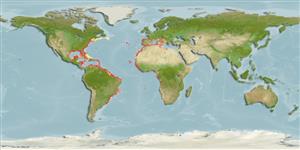Preferred temperature (Ref.
115969): 13.5 - 27.8, mean 24.3 (based on 900 cells).
Phylogenetic diversity index (Ref.
82804): PD
50 = 0.5010 [Uniqueness, from 0.5 = low to 2.0 = high].
Bayesian length-weight: a=0.01148 (0.00755 - 0.01745), b=2.98 (2.85 - 3.11), in cm Total Length, based on LWR estimates for this species & Genus-body shape (Ref.
93245).
Niveau trophique (Ref.
69278): 4.4 ±0.0 se; based on diet studies.
Résilience (Ref.
120179): Haut, temps minimum de doublement de population inférieur à 15 mois (K=0.32; tm<1; Fec=28,600).
Prior r = 1.20, 95% CL = 0.79 - 1.80, Based on 1 stock assessment.
Fishing Vulnerability (Ref.
59153): Low to moderate vulnerability (34 of 100).
